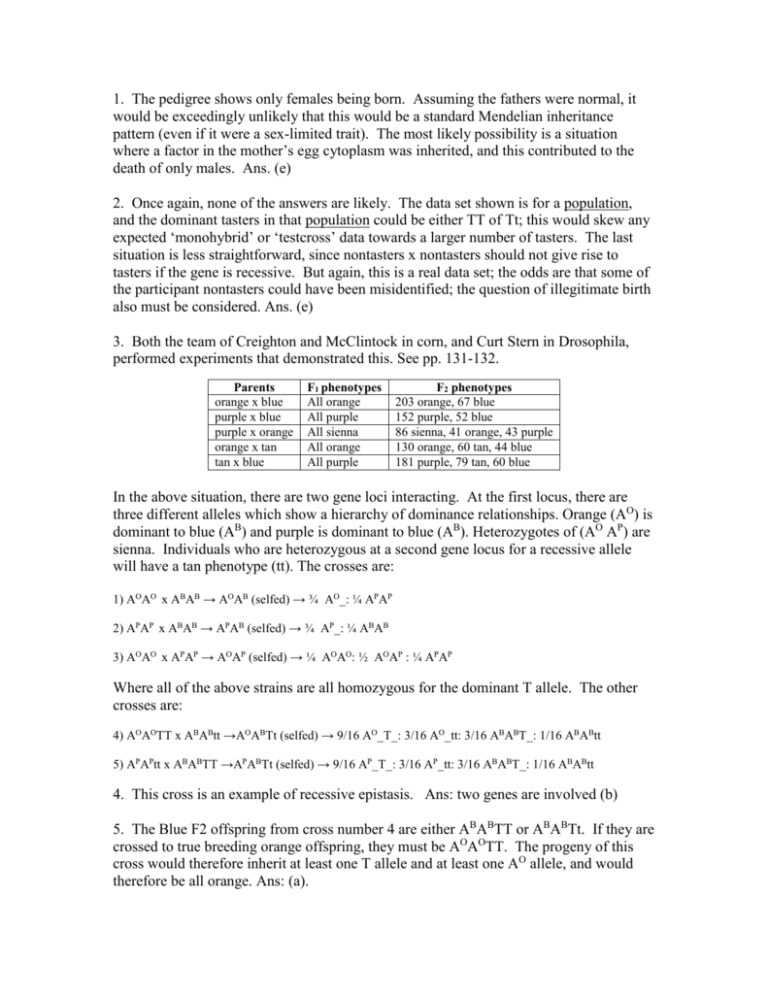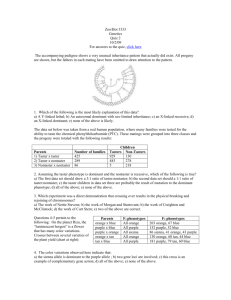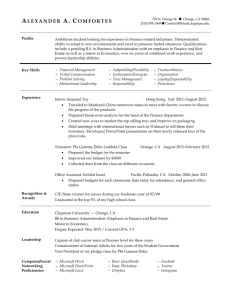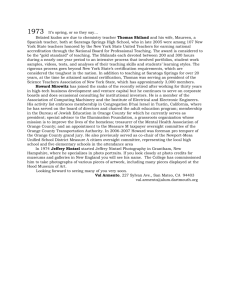click here
advertisement

1. The pedigree shows only females being born. Assuming the fathers were normal, it would be exceedingly unlikely that this would be a standard Mendelian inheritance pattern (even if it were a sex-limited trait). The most likely possibility is a situation where a factor in the mother’s egg cytoplasm was inherited, and this contributed to the death of only males. Ans. (e) 2. Once again, none of the answers are likely. The data set shown is for a population, and the dominant tasters in that population could be either TT of Tt; this would skew any expected ‘monohybrid’ or ‘testcross’ data towards a larger number of tasters. The last situation is less straightforward, since nontasters x nontasters should not give rise to tasters if the gene is recessive. But again, this is a real data set; the odds are that some of the participant nontasters could have been misidentified; the question of illegitimate birth also must be considered. Ans. (e) 3. Both the team of Creighton and McClintock in corn, and Curt Stern in Drosophila, performed experiments that demonstrated this. See pp. 131-132. Parents orange x blue purple x blue purple x orange orange x tan tan x blue F1 phenotypes All orange All purple All sienna All orange All purple F2 phenotypes 203 orange, 67 blue 152 purple, 52 blue 86 sienna, 41 orange, 43 purple 130 orange, 60 tan, 44 blue 181 purple, 79 tan, 60 blue In the above situation, there are two gene loci interacting. At the first locus, there are three different alleles which show a hierarchy of dominance relationships. Orange (AO) is dominant to blue (AB) and purple is dominant to blue (AB). Heterozygotes of (AO AP) are sienna. Individuals who are heterozygous at a second gene locus for a recessive allele will have a tan phenotype (tt). The crosses are: 1) AOAO x ABAB → AOAB (selfed) → ¾ AO_: ¼ APAP 2) APAP x ABAB → APAB (selfed) → ¾ AP_: ¼ ABAB 3) AOAO x APAP → AOAP (selfed) → ¼ AOAO: ½ AOAP : ¼ APAP Where all of the above strains are all homozygous for the dominant T allele. The other crosses are: 4) AOAOTT x ABABtt →AOABTt (selfed) → 9/16 AO_T_: 3/16 AO_tt: 3/16 ABABT_: 1/16 ABABtt 5) APAPtt x ABABTT →APABTt (selfed) → 9/16 AP_T_: 3/16 AP_tt: 3/16 ABABT_: 1/16 ABABtt 4. This cross is an example of recessive epistasis. Ans: two genes are involved (b) 5. The Blue F2 offspring from cross number 4 are either ABABTT or ABABTt. If they are crossed to true breeding orange offspring, they must be AOAOTT. The progeny of this cross would therefore inherit at least one T allele and at least one AO allele, and would therefore be all orange. Ans: (a). Phenotype +bc a+c abc ++c a++ ab+ +++ +b+ Number of progeny 436 91 6 92 440 87 8 98 6. The parental classes are + b c and a + +; the DCO classes are a b c and + + +. The middle gene is therefore a and the genes are in the following configuration in the heterozygous parent: b + c + a + Crossovers in b----a interval: 87 ba+ 92 ++c 6 bac 8 +++ 193, out of 1258 total progeny 193/1258 = 0.153 = 15.3 map units Crossovers in a------c interval: 98 b++ 91 +ac 6 bac 8 +++ 203, out of 1258 total progeny; 203/1258 = 0.161 = 16.1 map units 6. The distance between the a and b genes is 15.3 map units; Ans: (c) 7. The number of expected double crossovers is: 30.9. We see 14 double cross overs, therefore our coefficient of coincidence is 14/30.9 = 0.45 We are seeing about 45 percent of what we expect, not 1.1%. Ans: False. Phenotype +bc a+c abc ++c a++ ab+ +++ +b+ Number of progeny 228 19 20 234 231 227 21 20 When we look at the categories here, we need to determine which gene are linked to one another. For example if the a and b loci were not linked and were segregating independently, we would expect the 4 possibilities of gametes to segregate independently: ++ = 234 + 21 ab = 20 + 227 +b = 228 + 20 a+ = 19 + 231 The a and b loci, therefore are NOT linked. When we compare a and c however: ++ = 21 + 20 ac = 19 + 20 a+ = 231 + 227 +c = 228 + 234 The a and c loci ARE linked. The most common classes are in the trans phasing relationship and therefore represent the parental combinations: + c a + b + 8. The answer would be true. 9. The b gene is unlinked and segregates independently of the a and c genes. The a and c genes are separated by 80/1000 = 0.08 or 8 map units. Ans: none of the above (e). Spore pair 1-2 3-4 5-6 7-8 total td+ td+ tdtd53 tdtd+ td+ td7 Ascus type tdtdtd+ td+ 47 tdtd+ tdtd+ 8 10. The number of second division segregation patterns is 7 + 8 + 5 = 20. The total number of asci are: 120 RF = 20/120 * ½ = 0.083 = 8.3 map units. Ans: (b). td+ tdtdtd+ 5







